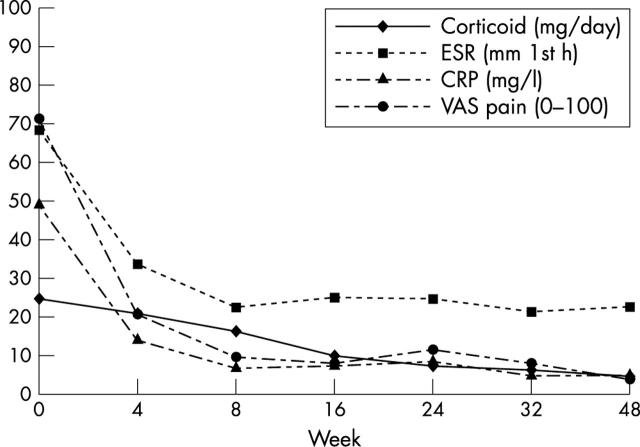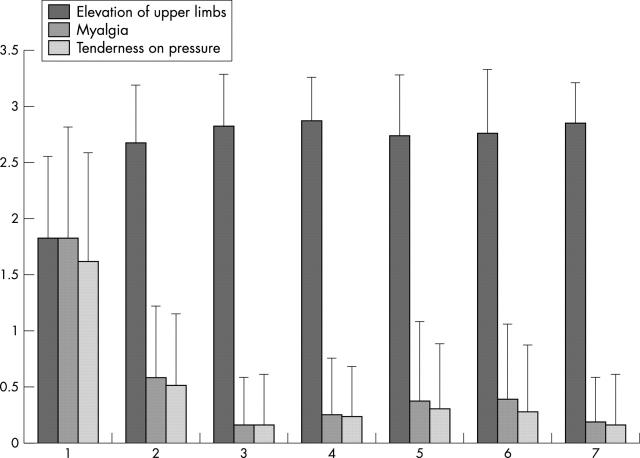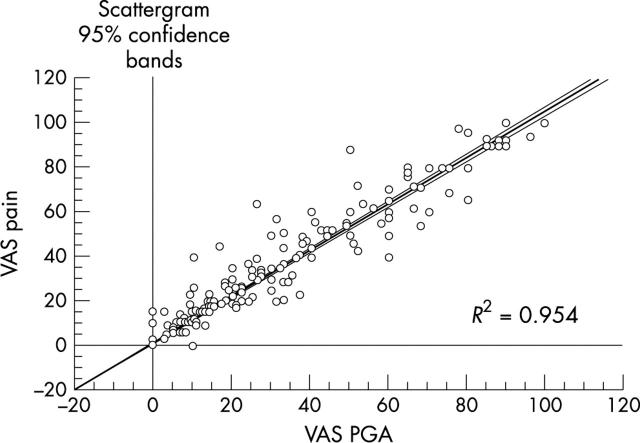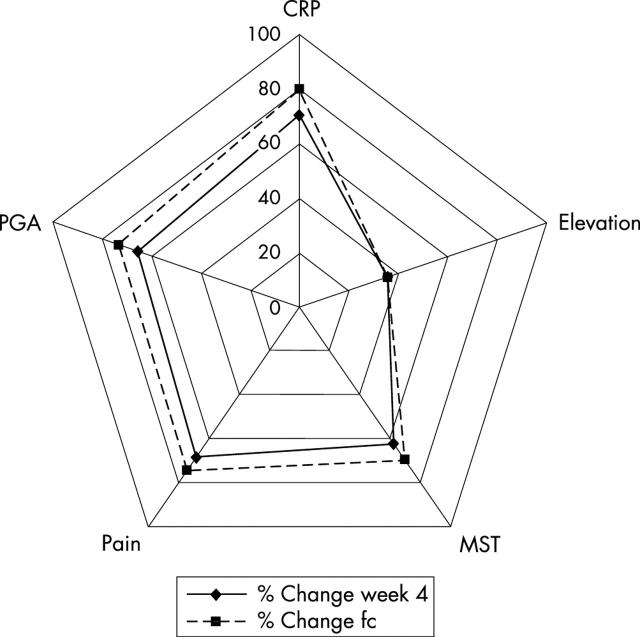Abstract
Objective: To develop response criteria for polymyalgia rheumatica (PMR) for monitoring treatment and comparing alternative treatments regimens.
Methods: 76 patients, mean (SD) age 68.7 (7.7) years, were enrolled. Corticosteroids, and non-steroidal anti-inflammatory drugs (NSAIDs) were the only drugs allowed during the observation period. Erythrocyte sedimentation rate (ESR), C reactive protein (CRP), α2 globulin, serum iron, pain, physician's global assessment (PGA), morning stiffness (MST), muscle tenderness (MT), myalgia, and the elevation of upper limbs (EUL) were determined regularly. The daily corticosteroid and NSAID doses as the corticosteroid response time were recorded. To ensure evaluation of an adequate number of patients (n = 57) week 24 was chosen for final analysis.
Results: ESR, CRP, α2 globulin, pain, PGA, MST, myalgia, MT, and EUL showed significant improvement (p<0.0001) at week 24 compared with week 0. Multiple regression analysis showed that changes of ESR (p = 0.08), CRP (p = 0.41), α2 globulin (p = 0.13), MST (p = 0.1), and MT (p = 0.07) were independent of pain, but myalgia (p<0.001) and EUL (p = 0.003) were pain dependent. Consequently, a core set of PMR response criteria, comprising ESR or CRP, pain, PGA, MST, and EUL was established. Assessment of treatment responses with this core set resulted in 90%, 70%, 50%, and 20% improvement in 31/57 (54%), 46/57 (81%), 51/57 (89%), and 54/57 (95%) of the patients, respectively.
Conclusion: These PMR response criteria are a promising tool for better monitoring of disease activity and treatment in PMR. It is proposed that these criteria should be used in clinical trials in the near future to explore alternative treatment options for PMR.
Full Text
The Full Text of this article is available as a PDF (243.2 KB).
Figure 1 .
Scheduled visits throughout the observational period and numbers of patients in the European patient cohort.
Figure 2 .
Course of ESR (mm/1st h), CRP (mg/l) levels and changes in pain (VAS) as well as daily corticosteroid dose in the original patient group.
Figure 3 .
Changes in the ability to raise the arms, in myalgia, and in muscle tenderness (four point scale) in the original patient group.
Figure 4 .
Regression analysis VAS pain v VAS physician's global assessment; R2 = 0.954 in the European patient cohort.
Figure 5 .
Percentage changes of the core set parameters from baseline in the Austrian patient group (n = 24). fc, final control.
Selected References
These references are in PubMed. This may not be the complete list of references from this article.
- Bird H. A., Esselinckx W., Dixon A. S., Mowat A. G., Wood P. H. An evaluation of criteria for polymyalgia rheumatica. Ann Rheum Dis. 1979 Oct;38(5):434–439. doi: 10.1136/ard.38.5.434. [DOI] [PMC free article] [PubMed] [Google Scholar]
- Cantini F., Salvarani C., Olivieri I., Macchioni L., Ranzi A., Niccoli L., Padula A., Boiardi L. Erythrocyte sedimentation rate and C-reactive protein in the evaluation of disease activity and severity in polymyalgia rheumatica: a prospective follow-up study. Semin Arthritis Rheum. 2000 Aug;30(1):17–24. doi: 10.1053/sarh.2000.8366. [DOI] [PubMed] [Google Scholar]
- Chuang T. Y., Hunder G. G., Ilstrup D. M., Kurland L. T. Polymyalgia rheumatica: a 10-year epidemiologic and clinical study. Ann Intern Med. 1982 Nov;97(5):672–680. doi: 10.7326/0003-4819-97-5-672. [DOI] [PubMed] [Google Scholar]
- Cimmino M. A., Zaccaria A. Epidemiology of polymyalgia rheumatica. Clin Exp Rheumatol. 2000 Jul-Aug;18(4 Suppl 20):S9–11. [PubMed] [Google Scholar]
- De Silva M., Hazleman B. L. Azathioprine in giant cell arteritis/polymyalgia rheumatica: a double-blind study. Ann Rheum Dis. 1986 Feb;45(2):136–138. doi: 10.1136/ard.45.2.136. [DOI] [PMC free article] [PubMed] [Google Scholar]
- Epperly T. D., Moore K. E., Harrover J. D. Polymyalgia rheumatica and temporal arthritis. Am Fam Physician. 2000 Aug 15;62(4):789-96, 801. [PubMed] [Google Scholar]
- Evans J. M., Hunder G. G. Polymyalgia rheumatica and giant cell arteritis. Rheum Dis Clin North Am. 2000 Aug;26(3):493–515. doi: 10.1016/s0889-857x(05)70153-8. [DOI] [PubMed] [Google Scholar]
- Feinberg H. L., Sherman J. D., Schrepferman C. G., Dietzen C. J., Feinberg G. D. The use of methotrexate in polymyalgia rheumatica. J Rheumatol. 1996 Sep;23(9):1550–1552. [PubMed] [Google Scholar]
- Ferraccioli G., Salaffi F., De Vita S., Casatta L., Bartoli E. Methotrexate in polymyalgia rheumatica: preliminary results of an open, randomized study. J Rheumatol. 1996 Apr;23(4):624–628. [PubMed] [Google Scholar]
- Gabriel S. E., Sunku J., Salvarani C., O'Fallon W. M., Hunder G. G. Adverse outcomes of antiinflammatory therapy among patients with polymyalgia rheumatica. Arthritis Rheum. 1997 Oct;40(10):1873–1878. doi: 10.1002/art.1780401022. [DOI] [PubMed] [Google Scholar]
- González-Gay M. A., García-Porrúa C., Vázquez-Caruncho M., Dababneh A., Hajeer A., Ollier W. E. The spectrum of polymyalgia rheumatica in northwestern Spain: incidence and analysis of variables associated with relapse in a 10 year study. J Rheumatol. 1999 Jun;26(6):1326–1332. [PubMed] [Google Scholar]
- González-Gay M. A., Rodríguez-Valverde V., Blanco R., Fernández-Sueiro J. L., Armona J., Figueroa M., Martínez-Taboada V. M. Polymyalgia rheumatica without significantly increased erythrocyte sedimentation rate. A more benign syndrome. Arch Intern Med. 1997 Feb 10;157(3):317–320. doi: 10.1001/archinte.1997.00440240081012. [DOI] [PubMed] [Google Scholar]
- Jones J. G., Hazleman B. L. Prognosis and management of polymyalgia rheumatica. Ann Rheum Dis. 1981 Feb;40(1):1–5. doi: 10.1136/ard.40.1.1. [DOI] [PMC free article] [PubMed] [Google Scholar]
- Kalke S., Mukerjee D., Dasgupta B. A study of the health assessment questionnaire to evaluate functional status in polymyalgia rheumatica. Rheumatology (Oxford) 2000 Aug;39(8):883–885. doi: 10.1093/rheumatology/39.8.883. [DOI] [PubMed] [Google Scholar]
- Kyle V., Cawston T. E., Hazleman B. L. Erythrocyte sedimentation rate and C reactive protein in the assessment of polymyalgia rheumatica/giant cell arteritis on presentation and during follow up. Ann Rheum Dis. 1989 Aug;48(8):667–671. doi: 10.1136/ard.48.8.667. [DOI] [PMC free article] [PubMed] [Google Scholar]
- Narváez J., Nolla-Solé J. M., Clavaguera M. T., Valverde-García J., Roig-Escofet D. Longterm therapy in polymyalgia rheumatica: effect of coexistent temporal arteritis. J Rheumatol. 1999 Sep;26(9):1945–1952. [PubMed] [Google Scholar]
- Narváez J., Nolla-Solé J. M., Clavaguera M. T., Valverde-García J., Roig-Escofet D. Longterm therapy in polymyalgia rheumatica: effect of coexistent temporal arteritis. J Rheumatol. 1999 Sep;26(9):1945–1952. [PubMed] [Google Scholar]
- Nobunaga M., Yoshioka K., Yasuda M., Shingu M. Clinical studies of polymyalgia rheumatica. A proposal of diagnostic criteria. Jpn J Med. 1989 Jul-Aug;28(4):452–456. doi: 10.2169/internalmedicine1962.28.452. [DOI] [PubMed] [Google Scholar]
- Proven A., Gabriel S. E., O'Fallon W. M., Hunder G. G. Polymyalgia rheumatica with low erythrocyte sedimentation rate at diagnosis. J Rheumatol. 1999 Jun;26(6):1333–1337. [PubMed] [Google Scholar]
- Weyand C. M., Fulbright J. W., Evans J. M., Hunder G. G., Goronzy J. J. Corticosteroid requirements in polymyalgia rheumatica. Arch Intern Med. 1999 Mar 22;159(6):577–584. doi: 10.1001/archinte.159.6.577. [DOI] [PubMed] [Google Scholar]
- Whittaker P. E., Fitzsimons M. G. A 24-year-old man with symptoms and signs of polymyalgia rheumatica. J Fam Pract. 1998 Jul;47(1):68–71. [PubMed] [Google Scholar]
- Wilke W. S., Wysenbeek A. J., Krall P. L., Segal A. M. Masked presentation of giant-cell arteritis. Cleve Clin Q. 1985 Summer;52(2):155–159. doi: 10.3949/ccjm.52.2.155. [DOI] [PubMed] [Google Scholar]







